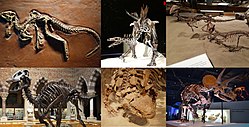Ornithischia
Ornithischia er en uddød gruppe af primært planteædende dinosaurer, der var karakteriseret af et bækkenparti, der minder om fuglenes.[1] Navnet Ornithischia ('med fuglebækken') afspejler denne lighed, idet det er afledt af de oldgræske ord ornith- (ὀρνιθ-), der betyder "fra en fugl" og ischion (ἴσχιον), flertal ischia, der betyder "hofteled". Fugle er dog kun fjernt i familie med denne gruppe, da fugle er theropoder.[1]
| Ornithischia | |
|---|---|
 Seks forskellige arter fra Ornithischia. I læseretningen: Heterodontosaurus tucki, Stegosaurus stenops, Scolosaurus thronus, Edmontosaurus annectens, Stegoceras validum og Triceratops horridus. | |
| Videnskabelig klassifikation | |
| Rige | Animalia (Dyr) |
| Række | Chordata (Chordater) |
| Underrække | Vertebrata (Hvirveldyr) |
| Overklasse | Tetrapoda (Tetrapoder) |
| Klasse | Reptilia (Krybdyr) |
| Overorden | †Dinosauria (Dinosaurer) |
| Orden | †Ornithischia |
| Udvalgte slægter | |
| Hjælp til læsning af taksobokse | |
Velkendte ornithischier omfattes af grupperne ceratopsier (fx Triceratops), Thyreophora (fx Stegosaurus og Ankylosaurus), pachycephalosaurer og ornithopoder.[1] Der er stærk evidens for, at visse grupper af ornithischier levede i flok,[1][2] ofte opdelt efter alder, hvor unge individer dannede egne flokke, adskilt fra de voksne.[3] Nogle var i det mindste delvist dækket af hår- eller fjerlignende pels, og der er meget debat om det kan have været primitive fjer hos Tianyulong,[4] Psittacosaurus[5] og Kulindadromeus.[6]
Klassificering redigér
Ornithischia bliver defineret som alle dinosaurer, der er tættere beslægtet med Triceratops horridus Marsh, 1889 end med både Passer domesticus (Linnaeus, 1758) og Saltasaurus loricatus Bonaparte & Powell, 1980.[7] Som det ses af kladogrammerne nedenfor består gruppen Genasauria af Thyreophora og Neornithischia. Thyreophora omfatter Stegosauria (som den pansrede Stegosaurus) og Ankylosauria (som Ankylosaurus). Neornithischia omfatter flere basale taksa: Marginocephalia (Ceratopsia og Pachycephalosauria) og Ornithopoda (inklusiv andenæbsøgler (hadrosaurer) som Edmontosaurus). Cerapoda er et relativt nyt koncept (Sereno, 1986).
Kladogrammet nedenfor følger en analyse fra 2009 af Zheng et al. Alle testede medlemmer af Heterodontosauridae danner en polytomi.[8]
| Ornithischia |
| |||||||||||||||||||||||||||||||||||||||||||||||||||||||||||||||||||||||||||||||||||||||||||||||||||
Kladogram efter Butler et al., 2011. Ornithopoda inkluderer Hypsilophodon, Jeholosaurus og andre.[4]
| Ornithischia |
| |||||||||||||||||||||||||||||||||||||||||||||||||||||||||||||||||||||||||||||||||||||||
Referencer redigér
- ^ a b c d Fastovsky, David E.; Weishampel, David B. (2012). Dinosaurs: A Concise Natural History. Cambridge: Cambridge University Press. ISBN 978-1107276468.
- ^ Qi, Zhao; Barrett, Paul M.; Eberth, David A. (2007-09-01). "Social Behaviour and Mass Mortality in the Basal Ceratopsian Dinosaur Psittacosaurus (early Cretaceous, People's Republic of China)". Palaeontology (engelsk). 50 (5): 1023-1029. doi:10.1111/j.1475-4983.2007.00709.x. ISSN 1475-4983.
- ^ Zhao, Q. (2013). "Juvenile-only clusters and behaviour of the Early Cretaceous dinosaur Psittacosaurus". Acta Palaeontologica Polonica. doi:10.4202/app.2012.0128.
- ^ a b Richard J. Butler, Jin Liyong, Chen Jun, Pascal Godefroit (maj 2011). "The postcranial osteology and phylogenetic position of the small ornithischian dinosaur Changchunsaurus parvus from the Quantou Formation (Cretaceous: Aptian–Cenomanian) of Jilin Province, north-eastern China". Palaeontology. 54 (3): 667-683. doi:10.1111/j.1475-4983.2011.01046.x.
{{cite journal}}: CS1-vedligeholdelse: Flere navne: authors list (link) - ^ Mayr, Gerald; Peters, Stefan D.; Plodowski, Gerhard; Vogel, Olaf (2002-08-01). "Bristle-like integumentary structures at the tail of the horned dinosaur Psittacosaurus". Naturwissenschaften (engelsk). 89 (8): 361-365. doi:10.1007/s00114-002-0339-6. ISSN 0028-1042. PMID 12435037.
- ^ Godefroit, P.; Sinitsa, S.M.; Dhouailly, D.; Bolotsky, Y.L.; Sizov, A.V.; McNamara, M.E.; Benton, M.J.; Spagna, P. (2014). "A Jurassic ornithischian dinosaur from Siberia with both feathers and scales" (PDF). Science. 345 (6195): 451-455. doi:10.1126/science.1253351. hdl:1983/a7ae6dfb-55bf-4ca4-bd8b-a5ea5f323103. PMID 25061209. Arkiveret fra originalen (PDF) 9. februar 2019. Hentet 13. maj 2019.
- ^ Butler, Richard; Upchurch, Paul; Norman, David (2008). "The phylogeny of ornithischian dinosaurs". Journal of Systematic Palaeontology. 6 (1): 1-40. doi:10.1017/S1477201907002271.
- ^ Zheng, Xiao-Ting; You, Hai-Lu; Xu, Xing; Dong, Zhi-Ming (19. marts 2009). "An Early Cretaceous heterodontosaurid dinosaur with filamentous integumentary structures". Nature. 458 (7236): 333-336. doi:10.1038/nature07856. PMID 19295609.